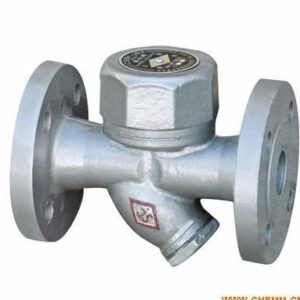Water traps are called traps, also known as automatic drains or condensate dischargers, and are divided into those used in steam systems and those used in gas systems. A water trap is installed at the end of a line heated by steam, and its function is to continuously discharge condensate from steam-heated piping to the outside of the piping. Most water evacuators can automatically identify steam and water (excluding thermostatic type), so as to achieve the purpose of automatic steam blocking and drainage. Water traps are widely used in petrochemical, food and pharmaceutical, and power plant industries, and play a major role in energy conservation and emission reduction. There are many types of traps, so we need to understand the principles of each type of trap before choosing a trap.

China industrial valves manufacturers
1 Float trap.
A float trap consists of a valve, a shaft, a guide tube, a float and a shell. When the condensate in the equipment or piping is pushed by steam pressure into the trap and gradually increases until it fills the float, the weight of the float exceeds the buoyancy and sinks downward, causing the throttle valve to open. This allows the condensate inside the barrel to be discharged through the conduit and valve under the action of steam pressure. When the condensate in the float is nearly finished, the weight of the float is reduced and floats upward, so that the throttle valve closes and condensate begins to accumulate in the float again. This works periodically to automatically discharge condensate and to prevent steam from escaping.
2 Bell-shaped float trap.
Bell-shaped float traps, also known as bucket traps, are mainly composed of a regulating valve, bucket, housing, and strainer. The bucket in the trap is inverted and starts in the down position, with the regulating valve open. When cold air and condensate in the equipment or piping are pushed by steam pressure into the trap, they are immediately discharged by the regulating valve. On the one hand, when steam and the small amount of air not discharged gradually fill the internal volume of the bucket, while condensate continues to accumulate, the bucket rises due to buoyancy, causing the regulating valve to close and stop discharging condensate. On the other hand, a small part of the steam and air inside the bucket is discharged from the small hole at the top of the bucket, while a large part of the heat is dissipated and condensed into liquid, so that the bucket buoyancy gradually decreases and falls, so that the regulating valve opens and the condensate is discharged again. This works periodically to automatically discharge condensate and to prevent steam from escaping.
3 Thermodynamic traps.
When the condensate in the equipment or piping flows into the air-impeding drain valve, the steam inside the pressure-transforming chamber condenses and reduces the pressure, and the force below the valve blade is greater than the force above it, so the valve blade is lifted. Because the viscosity of condensate is higher than that of steam and the flow rate is lower, it is not easy to cause negative pressure between the valve and the bottom of the valve, and condensate does not easily flow into the pressure change chamber through the gap between the valve and the housing, so that the valve remains open and the condensate flows out through the circumferential groove. When the steam in the equipment or piping flows into the trap, because the steam is less viscous than condensate and has a higher flow rate, it is easier to create negative pressure between the valve and the valve seat, and at the same time some of the steam flows into the pressure change chamber, so that the force on top of the valve is greater than the force below, causing the valve to close quickly. In this way, the periodic work, not only can automatically discharge condensate, but also to prevent steam from escaping.